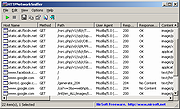Buy our over-priced crap to help keep things running.




















| Files | ||||
| File Name | Rating | Downloads | ||
| HTTPNetworkSniffer v1.63 32bit HTTPNetworkSniffer v1.63 32bit HTTPNetworkSniffer is a packet sniffer tool that captures all HTTP requests/responses sent between the Web browser and the Web server and displays them in a simple table. For every HTTP request, the following information is displayed: Host Name, HTTP method (GET, POST, HEAD), URL Path, User Agent, Response Code, Response String, Content Type, Referer, Content Encoding, Transfer Encoding, Server Name, Content Length, Cookie String, and more... You can easily select one or more HTTP information lines, and then export them to text/html/xml/csv file or copy them to the clipboard and then paste them into Excel. System Requirements This utility works on any version of Windows, starting from Windows 2000 and up to Windows 10, including 64-bit systems. One of the following capture drivers is required to use HTTPNetworkSniffer: WinPcap Capture Driver: WinPcap is an open source capture driver that allows you to capture network packets on any version of Windows. You can download and install the WinPcap driver from this Web page. Microsoft Network Monitor Driver version 2.x (Only for Windows 2000/XP/2003): Microsoft provides a free capture driver under Windows 2000/XP/2003 that can be used by HTTPNetworkSniffer, but this driver is not installed by default, and you have to manually install it, by using one of the following options: Option 1: Install it from the CD-ROM of Windows 2000/XP according to the instructions in Microsoft Web site Option 2 (XP Only) : Download and install the Windows XP Service Pack 2 Support Tools. One of the tools in this package is netcap.exe. When you run ... |
 |
8,748 | Dec 06, 2019 Nirsoft  |
|
| HTTPNetworkSniffer v1.63 64bit HTTPNetworkSniffer v1.63 64bit HTTPNetworkSniffer is a packet sniffer tool that captures all HTTP requests/responses sent between the Web browser and the Web server and displays them in a simple table. For every HTTP request, the following information is displayed: Host Name, HTTP method (GET, POST, HEAD), URL Path, User Agent, Response Code, Response String, Content Type, Referer, Content Encoding, Transfer Encoding, Server Name, Content Length, Cookie String, and more... You can easily select one or more HTTP information lines, and then export them to text/html/xml/csv file or copy them to the clipboard and then paste them into Excel. System Requirements This utility works on any version of Windows, starting from Windows 2000 and up to Windows 10, including 64-bit systems. One of the following capture drivers is required to use HTTPNetworkSniffer: WinPcap Capture Driver: WinPcap is an open source capture driver that allows you to capture network packets on any version of Windows. You can download and install the WinPcap driver from this Web page. Microsoft Network Monitor Driver version 2.x (Only for Windows 2000/XP/2003): Microsoft provides a free capture driver under Windows 2000/XP/2003 that can be used by HTTPNetworkSniffer, but this driver is not installed by default, and you have to manually install it, by using one of the following options: Option 1: Install it from the CD-ROM of Windows 2000/XP according to the instructions in Microsoft Web site Option 2 (XP Only) : Download and install the Windows XP Service Pack 2 Support Tools. One of the tools in this package is netcap.exe. When you run ... |
 |
8,920 | Dec 06, 2019 Nirsoft  |
|
| NetworkOpenedFiles v1.63 NetworkOpenedFiles v1.63 A simple tool for Windows that displays the list of all files that are currently opened by other computers on your network. For every opened filename, the following information is displayed: Filename, user name, computer name (On Windows 7/2008 or later), Permissions information (Read/Write/Create), locks count, file owner, file size, file attributes, and more... System Requirements This utility works on any version of Windows, starting from Windows XP and up to Windows 11, including Windows Server. Both 32-bit and 64-bit systems are supported. On systems older than Windows 7 or Windows Server 2008, NetworkOpenedFiles doesn't display the name of the computer that opened the files ('Computer' column) Start Using NetworkOpenedFiles NetworkOpenedFiles doesn't require any installation process or additional DLL files. In order to start using it, simply run the executable file - NetworkOpenedFiles.exe After running NetworkOpenedFiles, the main window displays the list of all files that are opened by other computers on your network. You can select one or more opened files, and then close them using the 'Close Selected Opened Files' option, export the files list to text/csv/tab-delimited/xml/html file using the 'Save Selected Items' option, or copy the files list to the clipboard (Ctrl+C) and paste it to Excel or any other spreadsheet application. Display Mode NetworkOpenedFiles allows you to display the opened files in 2 different modes: • Show all entries: In this mode, NetworkOpenedFiles displays all opened files, exactly as they are received from Windows operating system. • Merge items with the same filename+user+computer: In this mode, if there are multiple items with the same filename, user, and computer name - NetworkOpenedFiles merges them into one item. You can change the display mode from Options -> Display Mode. Connecting to a remote computer NetworkOpenedFiles also allows you to connect another computer on your network, ... |
 |
6,449 | Jul 26, 2024 Nir Sofer  |
|
| Showing rows 1 to 3 of 3 | Showing Page 1 of 1 | 1 |
OlderGeeks.com Copyright (c) 2025